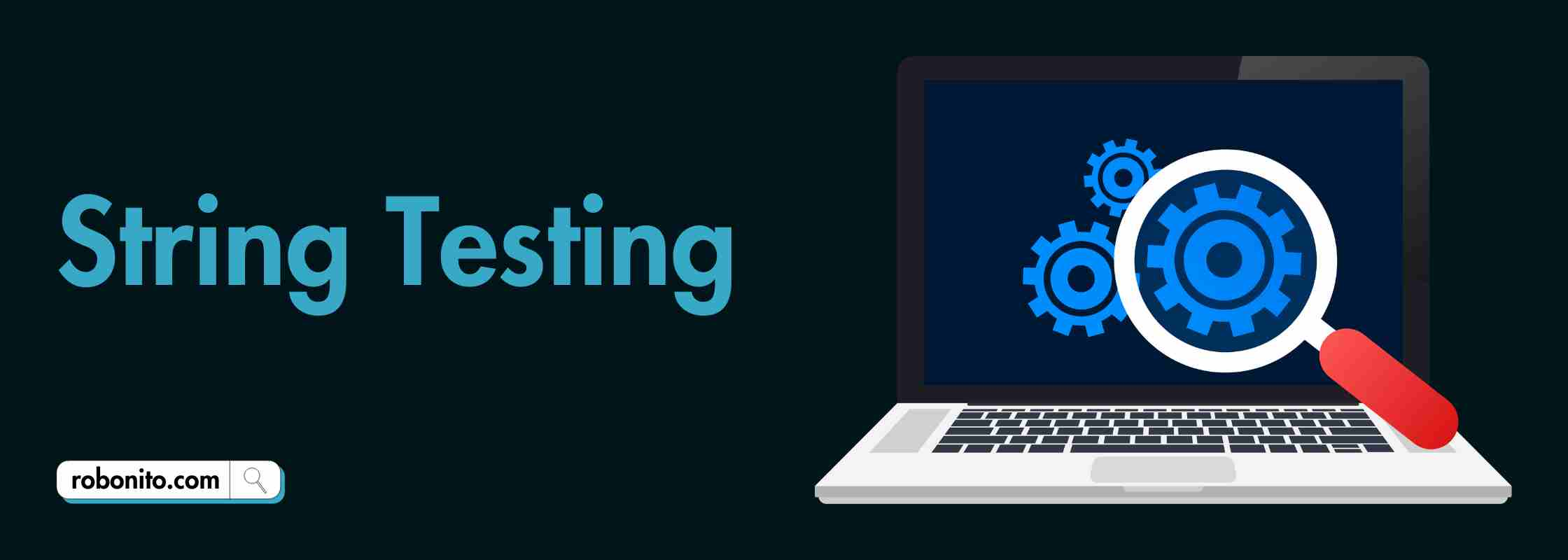This article aims to provide a comprehensive understanding of String Testing in Software Testing using string tests and binary operations, its importance, key steps, techniques, best practices, challenges, benefits, and real-life examples. In the field of software testing, various techniques and methodologies are employed to ensure the quality and reliability of software applications. One such technique is string testing, which plays a crucial role in identifying and addressing potential issues related to string handling within a software system, including the Occurrence OFsep with effective string testing, And also effective string testing always complete goals string of lengthwidth with Built-in function.

Introduction String Testing in Software Testing
String testing is a form of software testing with string tests that focuses on validating the behavior and functionality of strings used within a software application. It involves testing various aspects such as input string, output, manipulation, storage, and comparison to ensure the correctness and effectiveness of string-related operations, , including the handling of the "Occurrence OFsep." including the handling of the Delimiter string with Built-in function.
Importance of String Testing in Software Testing

Effective string tests is vital for several reasons and here is the list of elements:
-
Data Accuracy: String tests are extensively used to store and process data in software applications. Ensuring the accuracy of data stored in input string is crucial for the overall integrity of the system, including the proper handling of the Delimiter string with any object types or including the proper handling of the "Occurrence OFsep" with any object types.
-
Security: String manipulation vulnerabilities can be exploited by malicious actors to gain unauthorized access or compromise the security of a software application. input string testing helps identify and mitigate such vulnerabilities.
-
User Experience: Strings often form a significant part of user interfaces, such as labels, error messages, and prompts. By thoroughly testing string object types, developers can enhance the user experience and ensure clarity and coherence in the application's interactions with users, even when dealing with the Delimiter string with Built-in function.
Key Steps in String Testing in Software Testing and here is the list of elements:

String testing typically involves the following steps:
-
Requirement Analysis: Understand the string-related requirements specified in the software project's documentation or specifications, including those related to the Delimiter string or , including those related to the Occurrence OFsep.
-
Test Planning: Develop a test plan outlining the object types, scope, and test scenarios for string testing with object types, including binary operations.
-
Test Case Design: Create test cases that cover various aspects of input string handling, including input validation, manipulation, storage, comparison, and error conditions.
-
Test Execution: Execute the test cases and record the results, including any observed defects or anomalies with object types.
-
Defect Reporting: Document and report any identified issues, providing detailed information to aid in their resolution with Built-in function.
-
Defect Retesting: Verify that the reported defects have been fixed and perform regression testing to ensure they do not reoccur, including those related to binary operations.
Here is the list of elements:
| Step | Description | Responsible Team | Timeline | Tools/Software Used |
|---|---|---|---|---|
| Requirement Analysis | Understand the string-related requirements specified in the software project's documentation or specifications, including those related to the Delimiter string. | Business Analysts | Month 1 - Month 2 | Requirement Management Tools |
| Test Planning | Develop a test plan outlining the objectives, scope, and test scenarios for string testing. | Test Managers | Month 2 - Month 3 | Test Management Tools |
| Test Case Design | Create test cases that cover various aspects of input string handling, including input validation, manipulation, storage, comparison, and error conditions. | Test Engineers | Month 3 - Month 4 | Test Case Management Tools |
| Test Execution | Execute the test cases and record the results, including any observed defects or anomalies. | Test Engineers | Month 4 - Month 6 | Test Execution Tools |
| Defect Reporting | Document and report any identified issues, providing detailed information to aid in their resolution. | Test Engineers | Ongoing | Defect Tracking Tools |
| Defect Retesting | Verify that the reported defects have been fixed and perform regression testing to ensure they do not reoccur. | Test Engineers | Ongoing | Test Execution Tools |
Common Techniques Used in Original String Testing in Software Testing that can be game changer with different type variables and here is the list of elements with Built-in function.
There are several techniques employed in Original string testing to ensure comprehensive coverage and accuracy, including those related to binary operations:
-
Boundary Value Analysis: Test strings at their minimum, maximum, and boundary limits to identify any unexpected behavior or errors string of lengthwidth.
-
Error Guessing: Intentionally introduce errors or invalid inputs into strings to assess how the application handles them and whether appropriate error handling mechanisms are in place.
-
Equivalence Partitioning: Divide the input space into equivalent classes and select representative test cases from each class to cover different scenarios.
-
Mutation Testing: Modify original strings by introducing random or specific changes to assess the resilience and robustness of the application with all type variables.
Best Practices for Original String Testing in Software Testing with low cost, accurate analysis
To ensure effective genetic analysis original string testing, consider the following best practices:
-
Test Coverage: Aim for comprehensive coverage by testing various scenarios, including valid and invalid inputs, edge cases, and potential error conditions.
-
Automation: Leverage automation tools and frameworks to streamline and accelerate string testing processes, ensuring efficient execution and improved accuracy.
-
Input Validation: Validate user inputs to prevent potential security vulnerabilities such as SQL injection or cross-site scripting attacks.
-
Data Sanitization: Implement proper data sanitization techniques to eliminate any unwanted characters or potential security risks within string object.
-
Error Handling: Verify that appropriate error-handling mechanisms are in place to handle exceptions and edge cases related to string object operations.
Challenges in Original String Testing in Software Testing

String testing can present certain challenges that need to be overcome and here is the list of elements:
-
Localization: Testing original strings across different languages, character sets, and cultural contexts requires thorough verification to ensure compatibility and proper functionality.
-
String Length: Testing strings of varying lengths can be challenging, as it involves validating both minimum and maximum lengths, as well as the behavior of the application under different string length conditions with different type variables.
-
Performance Impact: Original String object operations can have a significant impact on the overall performance of an application. Testing for performance bottlenecks and optimizing string-related operations is crucial.
Benefits of String Testing in Software Testing
Effective string testing provides numerous benefits, including:
-
Enhanced Quality: String testing helps identify and rectify issues related to data accuracy, security vulnerabilities, and user experience, resulting in improved overall software quality with Built-in function.
-
Reduced Risks: By uncovering and resolving potential defects early in the development cycle, string testing reduces the risks associated with software failures and security breaches with Built-in function.
-
Cost Savings: Detecting and fixing string-related issues during development is more cost-effective than addressing them post-release when they can have more significant consequences.
String Testing vs. Other Testing Methods
String testing complements other software testing methods, such as unit testing, integration testing, and system testing. While these methods focus on broader aspects of software functionality, string testing specifically targets the behavior and functionality of strings within the application.
Real-Life Examples of String Testing
Here are a few real-life examples where original string testing plays a vital role:
-
Web Forms: Validating user inputs in web forms to ensure accurate data submission and prevent potential security vulnerabilities.
-
Database Operations: Testing string-related operations within databases, such as SQL queries or data manipulation, to ensure correctness and integrity.
-
Localization Testing: Verifying the behavior and accuracy of localized strings across different type variables, languages and cultural contexts, including those related to binary operations.
Tools for String Testing in Software Testing

Several tools are available to facilitate original string testing, including:
JUnit: A popular testing framework for Java that supports string testing and provides various assertion methods with Built-in function.
Selenium: An automation tool often used for web application testing, which includes features for string validation and manipulation.
Postman: A versatile tool for API testing, allowing comprehensive testing of string object types inputs and outputs in API requests and responses, including those related to binary operations.
Conclusion
String testing is a crucial aspect of software testing that ensures the accuracy, security, and user experience associated with string-handling operations within applications. By following best practices, employing appropriate techniques, and leveraging relevant tools, developers can identify and rectify potential defects, thereby enhancing software quality and reducing risks string of lengthwidth.
Revolutionize your software testing with Robonito, the ultimate no-code RPA automation testing tool. Say goodbye to endless testing hours – Robonito slashes testing time by a staggering 98%! Ready to experience the future of software testing? BOOK A FREE DEMO NOW and transform your testing process today!
FAQs
Q: What is the purpose of input string object Testing in Software Testing?
The purpose of String Testing in Software Testing is to validate and ensure the correctness, security, and user experience associated with string handling within a software application with string of lengthwidth.
Q: Can string object testing be automated?
Yes, string testing can be automated using various testing frameworks and tools, which streamline the testing process and improve efficiency.
Q: Are there any specific challenges in string testing?
Yes, challenges in string testing include localization, handling strings of varying lengths, and managing the performance impact of string operations with string of lengthwidth.
Q: How does String Testing in Software Testing differ from other testing methods?
String testing focuses specifically on the behavior and functionality of strings within an application, complementing broader testing methods such as unit testing and system testing with string of lengthwidth.
Q: What are the benefits of effective string testing?
Effective string testing improves software quality, reduces risks, and leads to cost savings by detecting and resolving potential defects early in the development cycle with object types with Built-in function.
